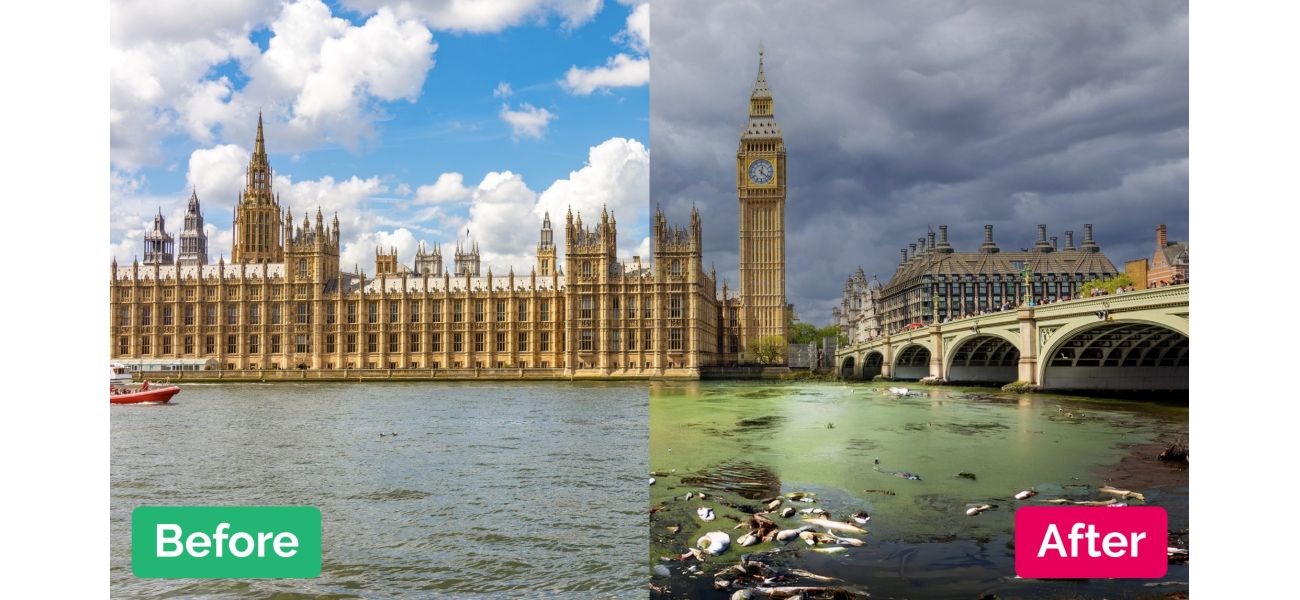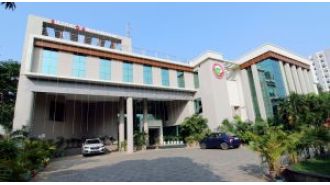Images show dead fish floating in rivers across UK, highlighting the sewage problem.
AI images serve as a warning of great concern.
November 28th 2024.

Have you ever imagined what could happen to the Thames if we don't address the issue of sewage pollution? It's a problem that has been plaguing UK rivers for some time now, but it's not always visible to the naked eye. The outlets where sewage is released are often tucked away from view. But what if the crisis is left unchecked? Well, experts have taken it upon themselves to paint a picture of what our beloved rivers might look like in the future, using AI-generated images.
In these images, we see a grim reality that we hope will never come to pass. Rotting fish floating in the Thames below Westminster Bridge, while algae and litter clog up the Wye, Ouse, Eden, and Severn rivers. These illustrations are not based on actual data, but the intention is to shock people into thinking about the impact of our actions on the environment.
The water companies have responded to these images, stating that they are purely fictional and would never happen, thanks to the billions of pounds they have invested in managing sewage more effectively. However, Utility Bidder, a comparison firm for services like water and electricity, claims otherwise in their Polluted Waters Report 2024. They state that sewage issues are only getting worse, with the number of recorded spills increasing nationwide.
The reason behind these AI-generated images is to show the potential consequences of rising sea levels and increased rainfall due to climate change. The creators used AI technology, specifically Midjourney and Adobe Firefly, to edit real photos of the rivers and show a polluted river with green algae, plastic waste, and dead fish. The result is a haunting blend of two images in Photoshop.
Severn Trent, one of the water companies, has spoken out against these images, calling them "fictional with no basis in reality." They believe that such misleading content only spreads false information and causes unnecessary concern among the public. They reassure the public that they are working hard to invest in reducing sewage spills, including a £250 million investment in Worcestershire alone, which aims to improve 134 storm overflows. They also claim to be investing more and progressing faster than any other water company in the UK.
Thames Water is also taking steps to upgrade their capabilities, with the construction of the £4.5 billion Tideway Tunnel, also known as the "super sewer." They have also made other investments that aim to capture 95% of the untreated sewage that currently enters the tidal Thames in a typical year. A spokesperson for Thames Water acknowledges that the wettest winter on record has overwhelmed their sewer system, resulting in discharges into rivers. They emphasize the importance of working together with other industries, such as farming and road maintenance, to improve river health.
So, what causes sewage pollution in UK rivers? One of the main culprits is the discharge of sewage through storm overflows, known as CSOs. These overflow valves are designed to release sewage into rivers during heavy rainfall to prevent pipes from becoming overwhelmed and causing sewage to back up into homes. However, these overflows are being relied upon too heavily across the country.
Another way that water pollution enters rivers is through misconnections. Faulty plumbing work can sometimes connect toilets and showers directly to watercourses, bypassing the sewage system. This results in waste water and sewage being dumped into rivers. Water UK, an organization representing water companies, states that no sewage spill is ever acceptable and that water companies have proposed investing £11 billion to end sewage entering rivers and seas. However, this plan needs to be approved by Ofwat, a government regulator.
The government's Discharge Reduction Plan aims to reduce storm overflow discharges by 25% from 2020 levels by 2025, as part of a mandatory £60 billion investment programme. But if AI-generated images of polluted rivers don't seem real enough, we can take a look at a real-life example of a river where sanitary towels and wet wipes are already pouring in every day. The River Brent in west London receives all the waste water and sewage from dozens of homes due to misconnections that have been there since the initial construction. This serves as a reminder that we must take action now to prevent our rivers from becoming polluted beyond repair.
In these images, we see a grim reality that we hope will never come to pass. Rotting fish floating in the Thames below Westminster Bridge, while algae and litter clog up the Wye, Ouse, Eden, and Severn rivers. These illustrations are not based on actual data, but the intention is to shock people into thinking about the impact of our actions on the environment.
The water companies have responded to these images, stating that they are purely fictional and would never happen, thanks to the billions of pounds they have invested in managing sewage more effectively. However, Utility Bidder, a comparison firm for services like water and electricity, claims otherwise in their Polluted Waters Report 2024. They state that sewage issues are only getting worse, with the number of recorded spills increasing nationwide.
The reason behind these AI-generated images is to show the potential consequences of rising sea levels and increased rainfall due to climate change. The creators used AI technology, specifically Midjourney and Adobe Firefly, to edit real photos of the rivers and show a polluted river with green algae, plastic waste, and dead fish. The result is a haunting blend of two images in Photoshop.
Severn Trent, one of the water companies, has spoken out against these images, calling them "fictional with no basis in reality." They believe that such misleading content only spreads false information and causes unnecessary concern among the public. They reassure the public that they are working hard to invest in reducing sewage spills, including a £250 million investment in Worcestershire alone, which aims to improve 134 storm overflows. They also claim to be investing more and progressing faster than any other water company in the UK.
Thames Water is also taking steps to upgrade their capabilities, with the construction of the £4.5 billion Tideway Tunnel, also known as the "super sewer." They have also made other investments that aim to capture 95% of the untreated sewage that currently enters the tidal Thames in a typical year. A spokesperson for Thames Water acknowledges that the wettest winter on record has overwhelmed their sewer system, resulting in discharges into rivers. They emphasize the importance of working together with other industries, such as farming and road maintenance, to improve river health.
So, what causes sewage pollution in UK rivers? One of the main culprits is the discharge of sewage through storm overflows, known as CSOs. These overflow valves are designed to release sewage into rivers during heavy rainfall to prevent pipes from becoming overwhelmed and causing sewage to back up into homes. However, these overflows are being relied upon too heavily across the country.
Another way that water pollution enters rivers is through misconnections. Faulty plumbing work can sometimes connect toilets and showers directly to watercourses, bypassing the sewage system. This results in waste water and sewage being dumped into rivers. Water UK, an organization representing water companies, states that no sewage spill is ever acceptable and that water companies have proposed investing £11 billion to end sewage entering rivers and seas. However, this plan needs to be approved by Ofwat, a government regulator.
The government's Discharge Reduction Plan aims to reduce storm overflow discharges by 25% from 2020 levels by 2025, as part of a mandatory £60 billion investment programme. But if AI-generated images of polluted rivers don't seem real enough, we can take a look at a real-life example of a river where sanitary towels and wet wipes are already pouring in every day. The River Brent in west London receives all the waste water and sewage from dozens of homes due to misconnections that have been there since the initial construction. This serves as a reminder that we must take action now to prevent our rivers from becoming polluted beyond repair.
[This article has been trending online recently and has been generated with AI. Your feed is customized.]
[Generative AI is experimental.]
0
0
Submit Comment





